An official website of the United States government
 United States Department of Labor
United States Department of Labor
Set up or repair rigging for construction projects, manufacturing plants, logging yards, ships and shipyards, or for the entertainment industry.
Employment estimate and mean wage estimates for Riggers:
| Employment (1) | Employment RSE (3) |
Mean hourly wage |
Mean annual wage (2) |
Wage RSE (3) |
|---|---|---|---|---|
| 21,700 | 4.4 % | $ 25.49 | $ 53,020 | 1.2 % |
Percentile wage estimates for Riggers:
| Percentile | 10% | 25% | 50% (Median) |
75% | 90% |
|---|---|---|---|---|---|
| Hourly Wage | $ 15.62 | $ 18.60 | $ 24.45 | $ 30.27 | $ 37.59 |
| Annual Wage (2) | $ 32,480 | $ 38,680 | $ 50,850 | $ 62,960 | $ 78,200 |
Industries with the highest published employment and wages for Riggers are provided. For a list of all industries with employment in Riggers, see the Create Customized Tables function.
Industries with the highest levels of employment in Riggers:
| Industry | Employment (1) | Percent of industry employment | Hourly mean wage | Annual mean wage (2) |
|---|---|---|---|---|
| Other Specialty Trade Contractors | 2,450 | 0.35 | $ 24.80 | $ 51,580 |
| Ship and Boat Building | 2,400 | 1.75 | $ 25.22 | $ 52,460 |
| Building Equipment Contractors | 1,750 | 0.08 | $ 26.13 | $ 54,340 |
| Federal Executive Branch (OEWS Designation) | 1,700 | 0.08 | $ 28.41 | $ 59,100 |
| Support Activities for Mining | 1,550 | 0.57 | $ 22.18 | $ 46,130 |
Industries with the highest concentration of employment in Riggers:
| Industry | Employment (1) | Percent of industry employment | Hourly mean wage | Annual mean wage (2) |
|---|---|---|---|---|
| Ship and Boat Building | 2,400 | 1.75 | $ 25.22 | $ 52,460 |
| Independent Artists, Writers, and Performers | 300 | 0.62 | $ 26.19 | $ 54,470 |
| Support Activities for Mining | 1,550 | 0.57 | $ 22.18 | $ 46,130 |
| Motion Picture and Video Industries | 1,480 | 0.45 | $ 30.80 | $ 64,060 |
| Promoters of Performing Arts, Sports, and Similar Events | 490 | 0.43 | $ 27.69 | $ 57,590 |
Top paying industries for Riggers:
| Industry | Employment (1) | Percent of industry employment | Hourly mean wage | Annual mean wage (2) |
|---|---|---|---|---|
| Petroleum and Coal Products Manufacturing | 60 | 0.06 | $ 44.15 | $ 91,820 |
| Electric Power Generation, Transmission and Distribution | 70 | 0.02 | $ 39.71 | $ 82,590 |
| Foundation, Structure, and Building Exterior Contractors | 110 | 0.01 | $ 31.29 | $ 65,090 |
| Motion Picture and Video Industries | 1,480 | 0.45 | $ 30.80 | $ 64,060 |
| Performing Arts Companies | 260 | 0.26 | $ 30.63 | $ 63,720 |
States and areas with the highest published employment, location quotients, and wages for Riggers are provided. For a list of all areas with employment in Riggers, see the Create Customized Tables function.
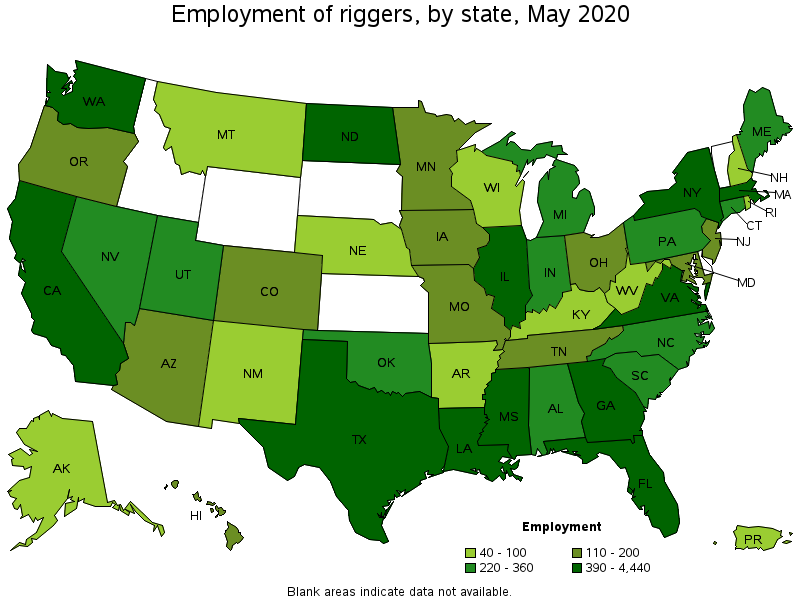
States with the highest employment level in Riggers:
| State | Employment (1) | Employment per thousand jobs | Location quotient (9) | Hourly mean wage | Annual mean wage (2) |
|---|---|---|---|---|---|
| Texas | 4,440 | 0.37 | 2.35 | $ 22.96 | $ 47,750 |
| California | 2,490 | 0.15 | 0.97 | $ 28.62 | $ 59,530 |
| Louisiana | 2,460 | 1.37 | 8.77 | $ 21.87 | $ 45,500 |
| Virginia | 1,560 | 0.42 | 2.71 | $ 24.34 | $ 50,620 |
| Florida | 980 | 0.12 | 0.75 | $ 23.67 | $ 49,230 |
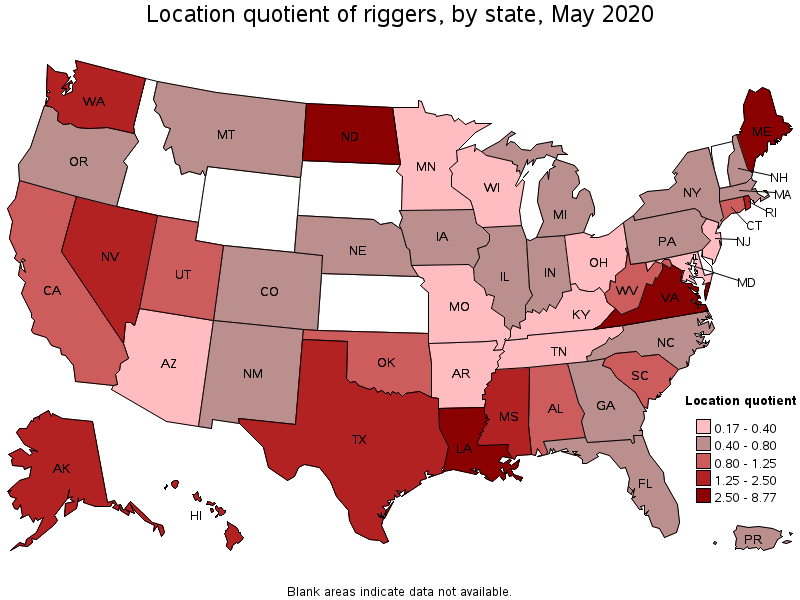
States with the highest concentration of jobs and location quotients in Riggers:
| State | Employment (1) | Employment per thousand jobs | Location quotient (9) | Hourly mean wage | Annual mean wage (2) |
|---|---|---|---|---|---|
| Louisiana | 2,460 | 1.37 | 8.77 | $ 21.87 | $ 45,500 |
| North Dakota | 390 | 0.97 | 6.25 | $ 25.88 | $ 53,830 |
| Maine | 330 | 0.58 | 3.70 | $ 26.11 | $ 54,310 |
| Virginia | 1,560 | 0.42 | 2.71 | $ 24.34 | $ 50,620 |
| Mississippi | 410 | 0.38 | 2.46 | $ 24.29 | $ 50,520 |
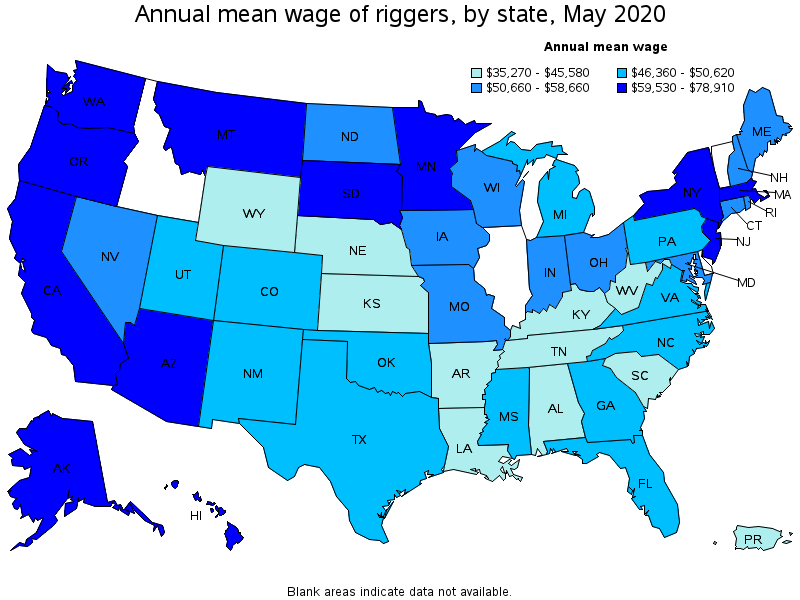
Top paying states for Riggers:
| State | Employment (1) | Employment per thousand jobs | Location quotient (9) | Hourly mean wage | Annual mean wage (2) |
|---|---|---|---|---|---|
| New York | 750 | 0.09 | 0.55 | $ 37.94 | $ 78,910 |
| Oregon | 200 | 0.11 | 0.71 | $ 32.75 | $ 68,110 |
| Alaska | 90 | 0.29 | 1.85 | $ 32.64 | $ 67,900 |
| Minnesota | 130 | 0.05 | 0.30 | $ 32.31 | $ 67,200 |
| New Jersey | 170 | 0.04 | 0.28 | $ 31.91 | $ 66,380 |
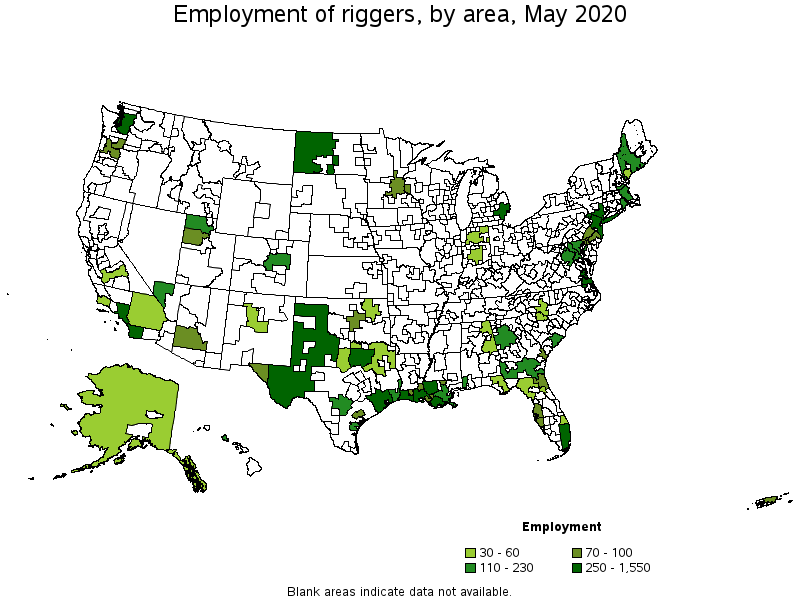
Metropolitan areas with the highest employment level in Riggers:
| Metropolitan area | Employment (1) | Employment per thousand jobs | Location quotient (9) | Hourly mean wage | Annual mean wage (2) |
|---|---|---|---|---|---|
| Los Angeles-Long Beach-Anaheim, CA | 1,550 | 0.27 | 1.71 | $ 28.50 | $ 59,290 |
| Virginia Beach-Norfolk-Newport News, VA-NC | 1,290 | 1.80 | 11.51 | $ 24.88 | $ 51,750 |
| Houston-The Woodlands-Sugar Land, TX | 1,280 | 0.43 | 2.76 | $ 23.93 | $ 49,770 |
| Dallas-Fort Worth-Arlington, TX | 1,070 | 0.30 | 1.91 | $ 23.12 | $ 48,100 |
| New York-Newark-Jersey City, NY-NJ-PA | 850 | 0.10 | 0.62 | $ 37.52 | $ 78,040 |
| Baton Rouge, LA | 790 | 2.13 | 13.67 | $ 27.69 | $ 57,600 |
| Houma-Thibodaux, LA | 610 | 7.42 | 47.59 | $ 16.18 | $ 33,650 |
| Bremerton-Silverdale, WA | 600 | 6.89 | 44.18 | $ 29.24 | $ 60,820 |
| Lafayette, LA | 390 | 2.07 | 13.27 | $ 17.76 | $ 36,950 |
| Miami-Fort Lauderdale-West Palm Beach, FL | 350 | 0.14 | 0.90 | $ 24.31 | $ 50,560 |
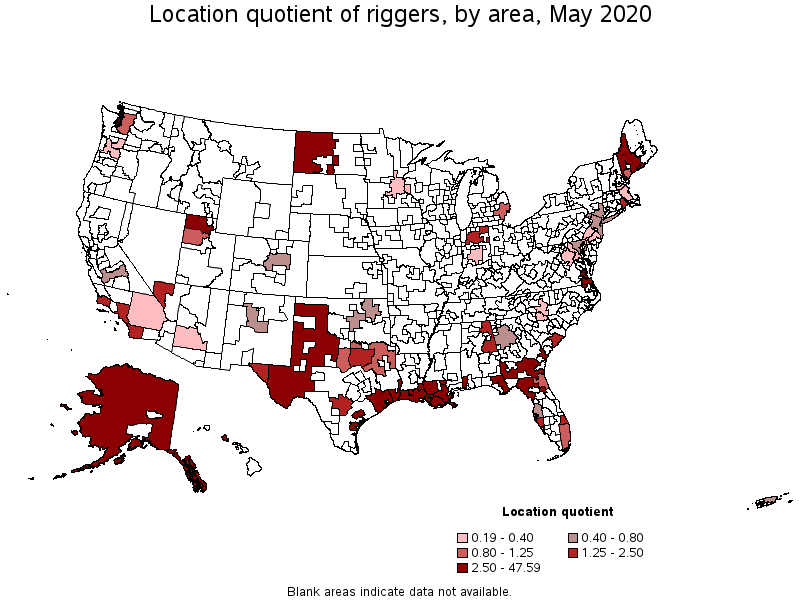
Metropolitan areas with the highest concentration of jobs and location quotients in Riggers:
| Metropolitan area | Employment (1) | Employment per thousand jobs | Location quotient (9) | Hourly mean wage | Annual mean wage (2) |
|---|---|---|---|---|---|
| Houma-Thibodaux, LA | 610 | 7.42 | 47.59 | $ 16.18 | $ 33,650 |
| Bremerton-Silverdale, WA | 600 | 6.89 | 44.18 | $ 29.24 | $ 60,820 |
| Lake Charles, LA | 250 | 2.49 | 15.95 | $ 25.85 | $ 53,760 |
| Baton Rouge, LA | 790 | 2.13 | 13.67 | $ 27.69 | $ 57,600 |
| Lafayette, LA | 390 | 2.07 | 13.27 | $ 17.76 | $ 36,950 |
| Victoria, TX | 70 | 1.98 | 12.66 | $ 19.26 | $ 40,050 |
| Virginia Beach-Norfolk-Newport News, VA-NC | 1,290 | 1.80 | 11.51 | $ 24.88 | $ 51,750 |
| Corpus Christi, TX | 190 | 1.03 | 6.61 | $ 23.45 | $ 48,770 |
| Mobile, AL | 160 | 0.93 | 5.98 | $ 23.21 | $ 48,280 |
| Beaumont-Port Arthur, TX | 110 | 0.74 | 4.75 | $ 29.55 | $ 61,470 |
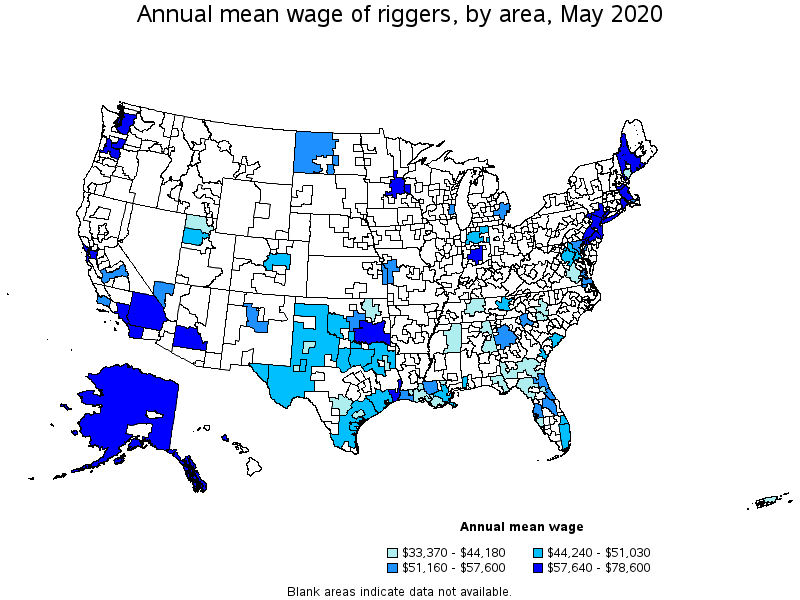
Top paying metropolitan areas for Riggers:
| Metropolitan area | Employment (1) | Employment per thousand jobs | Location quotient (9) | Hourly mean wage | Annual mean wage (2) |
|---|---|---|---|---|---|
| Minneapolis-St. Paul-Bloomington, MN-WI | 70 | 0.04 | 0.25 | $ 37.79 | $ 78,600 |
| New York-Newark-Jersey City, NY-NJ-PA | 850 | 0.10 | 0.62 | $ 37.52 | $ 78,040 |
| Portland-Vancouver-Hillsboro, OR-WA | 70 | 0.06 | 0.39 | $ 32.81 | $ 68,240 |
| Seattle-Tacoma-Bellevue, WA | 250 | 0.13 | 0.82 | $ 32.47 | $ 67,550 |
| Indianapolis-Carmel-Anderson, IN | 60 | 0.06 | 0.37 | $ 31.67 | $ 65,860 |
| Urban Honolulu, HI | 170 | 0.41 | 2.64 | $ 31.58 | $ 65,680 |
| Phoenix-Mesa-Scottsdale, AZ | 100 | 0.05 | 0.30 | $ 30.71 | $ 63,880 |
| San Francisco-Oakland-Hayward, CA | (8) | (8) | (8) | $ 30.67 | $ 63,800 |
| Bridgeport-Stamford-Norwalk, CT | (8) | (8) | (8) | $ 30.02 | $ 62,440 |
| Boston-Cambridge-Nashua, MA-NH | 140 | 0.05 | 0.34 | $ 29.73 | $ 61,840 |
Nonmetropolitan areas with the highest employment in Riggers:
| Nonmetropolitan area | Employment (1) | Employment per thousand jobs | Location quotient (9) | Hourly mean wage | Annual mean wage (2) |
|---|---|---|---|---|---|
| West North Dakota nonmetropolitan area | 360 | 3.15 | 20.18 | $ 25.54 | $ 53,130 |
| West Texas Region of Texas nonmetropolitan area | 260 | 1.33 | 8.50 | $ 23.15 | $ 48,150 |
| South Georgia nonmetropolitan area | 160 | 0.85 | 5.48 | $ 20.78 | $ 43,230 |
| Southwest Maine nonmetropolitan area | 140 | 0.76 | 4.87 | $ 27.71 | $ 57,640 |
| Southwest Louisiana nonmetropolitan area | 80 | 1.15 | 7.36 | $ 18.66 | $ 38,810 |
Nonmetropolitan areas with the highest concentration of jobs and location quotients in Riggers:
| Nonmetropolitan area | Employment (1) | Employment per thousand jobs | Location quotient (9) | Hourly mean wage | Annual mean wage (2) |
|---|---|---|---|---|---|
| West North Dakota nonmetropolitan area | 360 | 3.15 | 20.18 | $ 25.54 | $ 53,130 |
| West Texas Region of Texas nonmetropolitan area | 260 | 1.33 | 8.50 | $ 23.15 | $ 48,150 |
| Southwest Louisiana nonmetropolitan area | 80 | 1.15 | 7.36 | $ 18.66 | $ 38,810 |
| South Georgia nonmetropolitan area | 160 | 0.85 | 5.48 | $ 20.78 | $ 43,230 |
| Southwest Maine nonmetropolitan area | 140 | 0.76 | 4.87 | $ 27.71 | $ 57,640 |
Top paying nonmetropolitan areas for Riggers:
| Nonmetropolitan area | Employment (1) | Employment per thousand jobs | Location quotient (9) | Hourly mean wage | Annual mean wage (2) |
|---|---|---|---|---|---|
| Alaska nonmetropolitan area | 60 | 0.58 | 3.71 | $ 30.53 | $ 63,500 |
| Southeast Oklahoma nonmetropolitan area | (8) | (8) | (8) | $ 28.00 | $ 58,230 |
| Southwest Maine nonmetropolitan area | 140 | 0.76 | 4.87 | $ 27.71 | $ 57,640 |
| West North Dakota nonmetropolitan area | 360 | 3.15 | 20.18 | $ 25.54 | $ 53,130 |
| Northern Indiana nonmetropolitan area | 60 | 0.28 | 1.82 | $ 24.33 | $ 50,600 |
These estimates are calculated with data collected from employers in all industry sectors, all metropolitan and nonmetropolitan areas, and all states and the District of Columbia. The top employment and wage figures are provided above. The complete list is available in the downloadable XLS files.
The percentile wage estimate is the value of a wage below which a certain percent of workers fall. The median wage is the 50th percentile wage estimate—50 percent of workers earn less than the median and 50 percent of workers earn more than the median. More about percentile wages.
(1) Estimates for detailed occupations do not sum to the totals because the totals include occupations not shown separately. Estimates do not include self-employed workers.
(2) Annual wages have been calculated by multiplying the hourly mean wage by a "year-round, full-time" hours figure of 2,080 hours; for those occupations where there is not an hourly wage published, the annual wage has been directly calculated from the reported survey data.
(3) The relative standard error (RSE) is a measure of the reliability of a survey statistic. The smaller the relative standard error, the more precise the estimate.
(8) Estimate not released.
(9) The location quotient is the ratio of the area concentration of occupational employment to the national average concentration. A location quotient greater than one indicates the occupation has a higher share of employment than average, and a location quotient less than one indicates the occupation is less prevalent in the area than average.
Other OEWS estimates and related information:
May 2020 National Occupational Employment and Wage Estimates
May 2020 State Occupational Employment and Wage Estimates
May 2020 Metropolitan and Nonmetropolitan Area Occupational Employment and Wage Estimates
May 2020 National Industry-Specific Occupational Employment and Wage Estimates
Last Modified Date: March 31, 2021